On the Premier League homepage, expert Alex Keble said that Erik ten Hag is building a direct playing style, from which he analyzed the strengths and weaknesses of this style and wanted the Dutch coach to change.
Most experts consider Man Utd to be a club without a clear tactical identity. That is a view that has been put forward for quite some time and was once again reiterated by many people after Man Utd let Tottenham dominate possession in the 2-2 draw at Old Trafford on January 14.
"Man Utd need to develop a consistent style of play, otherwise I think Ten Hag's job will be in jeopardy," Gary Neville said after that game. "They really struggle to know where their team-mates are, to have combinations, patterns. I don't see that at the moment, and that's a real concern."
Neville's comments about United's quick and unstructured passing are true, but the Red Devils' style of play is no mystery to the public. In fact, Ten Hag has been very open about what he is trying to do and United are doing it.
Ten Hag’s tactics against Man Utd were based on speed and directness. The team started from a deeper position, looking to draw opponents forward and then explode with passes over the line to create space for the speedy strikers to exploit.
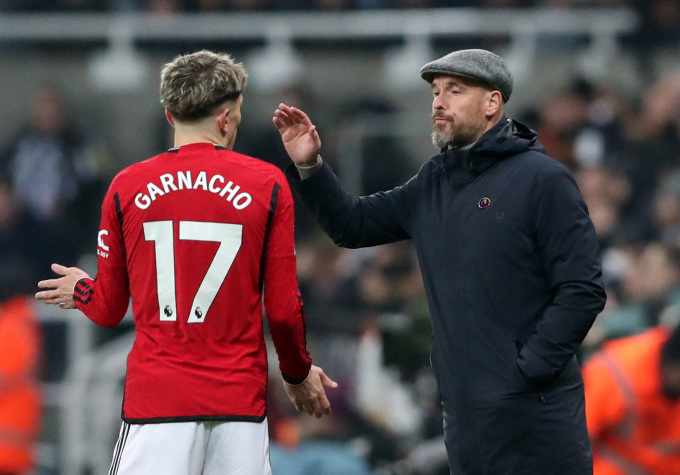
Coach Ten Hag talks with striker Garnacho during Man Utd's 0-1 loss to Newcastle in round 14 of the Premier League at St James' Park on December 2. Photo: Reuters
But in reality, according to Keble, the tactics were either unsuitable for the size of the club, poorly executed, or both. As a result, Man Utd continued to have inconsistent performances and created the impression that the team was less organised than it actually was.
Man Utd's DNA
After losing 0-3 to Man City at Old Trafford in October 2023, Ten Hag admitted that he could not build a playing style for Man Utd similar to when he was leading Ajax, because there were different players.
"I came here with a philosophy based on possession, but at the same time I wanted to combine it with the DNA of Man Utd, the players and their style," said the Dutchman. "Last year we played very good football. This season the philosophy is no different, I just want the team to be more direct. We want to press from different blocks and then play directly."
Man Utd have a long history of playing direct, fast, powerful attacks on both wings, stretching from Sir Alex Ferguson to Sir Matt Busby. And this is the "DNA" that Ten Hag mentioned.
From there, Man Utd's style of play can be understood as having low ball possession, a low formation, a number of fast forwards concentrated in the front line and explosive pressing designed to take advantage of situations transitioning from defense to attack.
Frontal attack
Sitting 17th, 13 points off the top of the Premier League table, with just one win in their last six games, Ten Hag’s tactics are clearly not working. But despite this run of results, Man Utd still have a recognisable style.
Man Utd have attempted 50 direct counter-attacks this season, the third-highest in the Premier League, while their progress rate of 1.89 metres per second is the fifth-highest. That’s the same as Luton Town and significantly higher than their 1.35 in 2022/23, which was 13th in the league. 57 offsides – the most in the Premier League – is another stat that highlights Man Utd’s desire to progress the ball quickly.
Defensively, Man Utd are second in the Premier League for possession with 208, and fourth for possession in the final third with 134. Ten Hag's men are also ninth for passes allowed per defensive action (PPDA) with 12.5.
These statistics show that Ten Hag's demand for sudden pressing relies on a carefully positioned midfield, compressed like a spring, ready to launch a counter-attack when the opposition is high up and off guard.
The 2-2 draw with Tottenham was a perfect example of these characteristics. The visitors had 63% possession and were encouraged to attack, leaving huge gaps in the full-back positions for Marcus Rashford and Alejandro Garnacho to run into and exploit.
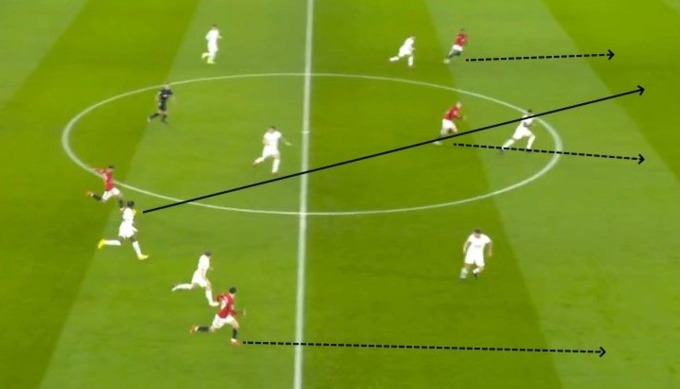
A counter-attack by Man Utd in the 2-2 draw with Tottenham. Screenshot
As the image above shows, Bruno Fernandes was tasked with initiating counter-attacks with long passes to Man Utd’s speedy front three. It’s a surprisingly simple tactic , based on the style Ten Hag developed at Ajax, and one that has so far proven ineffective.
The weakness of direct play
But that's not to say Man Utd don't have any tactics. Simple passing is a form of tactics, but it comes with its own problems.
Counter-attacking and direct play inherently disorganises the central midfield and makes planned, controlled passing structures difficult, so few big clubs in Europe are playing this style.
"The last time I saw such a combination of play and a series of passes that looked out of sync was under Louis van Gaal," Neville said. "What I see at Man Utd now is a series of individual passes, where a player receives the ball and seems to be trying to figure out where the next player is, rather than knowing where they are."
Neville is right about what worries Man Utd fans, as this sense of improvisation and lack of form is the downside of the tactical identity that Ten Hag is deploying.
In theory, the Red Devils could develop some mechanisms for building the ball from deep into the forward line through Bruno Fernandes, with set-pieces that would trigger a counter-attack. But fast, direct football is fluid in nature, requiring finesse and quick thinking in every situation as it is reactive rather than proactive.

Coach Ten Hag talks with captain Bruno Fernandes during the win over Aston Villa in round 19 of the Premier League. Photo: AFP
And if a system relies on errors or weaknesses in the opponent's transition, it's not being trained at the highest level on the training pitch. You're relying on the opponent, waiting for them to make mistakes, rather than proactively setting the game up.
The bigger problem
Man Utd's defensive problems can be better explained by comparing them to Man City. One of the core principles of Pep Guardiola's style of play at City is a slow and measured build-up, designed to ensure that every player remains in a compressed block. They move up and down in sync, gradually building up attacks, but also ensuring they are in the perfect position to defend when they lose possession.
Ten Hag’s fast, direct football at Man Utd is the complete opposite. The front three are high up the pitch, constantly running behind the opposition defence, while Fernandes is asked to pass long to the front line, causing Man Utd’s system to be stretched vertically. As a result, the gap between Man Utd’s defence and attack is often very large, and when opponents advance into the final third, their wingers are unable to drop back to support their respective full-backs.
An equally serious problem from a vertically stretched system is the large space that central midfielders must cover between the defensive and attacking lines.
Both of these issues were evident in the 2-2 draw with Tottenham, including the build-up to the visitors’ second goal. In the image below, you can see that the Man Utd midfielders have plenty of space around them and neither Garnacho nor Rashford are in the frame.
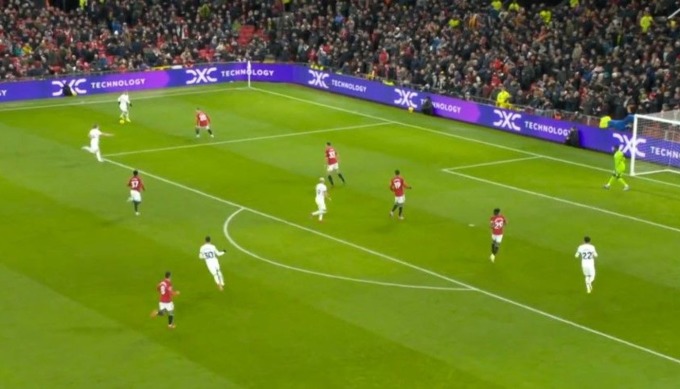
Man Utd's defense left too many gaps in the middle in the situation that led to Tottenham's equalizer 2-2 on January 14. Screenshot
This stretched system has allowed opponents to build up the ball easily against Man Utd. The result has been the fourth-highest number of one-v-ones in the Premier League with 442 and dribbles pasted 199 times - just three teams fewer than the other teams in the division. Man Utd have also allowed opponents to carry the ball 446 times - a figure only bettered by West Ham and Sheffield United.
Since then, Man Utd have conceded 315 shots - the fourth highest in the Premier League - and have allowed 556 shots - the fifth highest in the league, behind only West Ham, Sheffield United, Luton Town and Burnley.
Against Tottenham, the passing patterns of the two teams were clear. One team, in possession, compressed space and played clear automatic passes. The other played direct and spontaneously, leaving a lot of space.
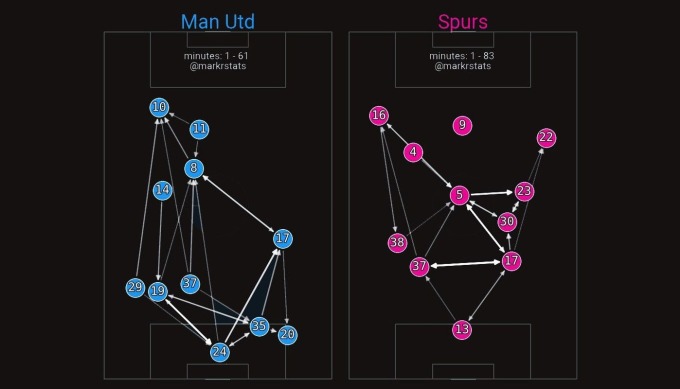
The pass maps show that Man Utd tend to pass long, leaving a lot of space, while Tottenham play in control, limiting the creation of space in the middle of the pitch. Photo: @markstats
Should Ten Hag change?
"The players ran at the wrong time, too late," Ten Hag said after a 2-0 defeat to Tottenham in August 2023. "Especially the front line did not drop back. The problem was not in the midfield but in the front line and the back line. That's why we had a lot of gaps."
In the defeat to Arsenal a few weeks later, Ten Hag said the same thing. "We were stretched and had to improve," he admitted. "The team has to be more cohesive, otherwise you can never counter-attack. I saw problems with the movement of the defence and the reaction of the attackers in transition."
Surely at some point Ten Hag must have wondered whether this approach was flawed, and whether it was worth trying to recreate Ajax football, regardless of the DNA or strengths and weaknesses of the Man Utd players.
"I want Man Utd to press high, take the initiative and keep the tempo high," Neville said. "Ten Hag said something a few weeks ago that he couldn't do that at Man Utd. It's interesting because other managers have shown that they can do that at Brighton and Tottenham. They don't even have the support in the transfer market that Man Utd have."
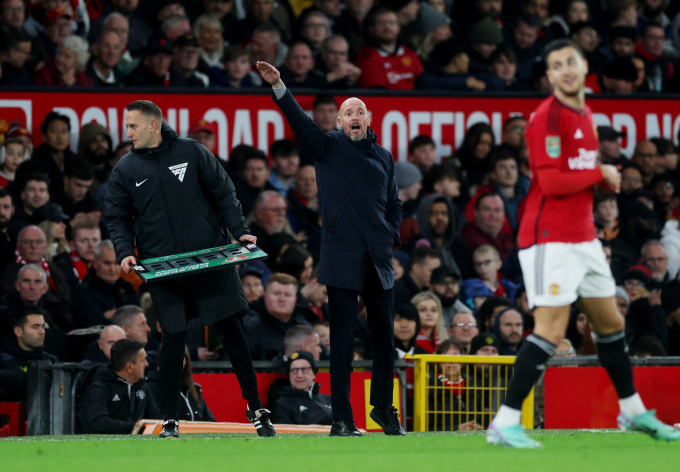
Coach Ten Hag directs the match Man Utd lost 0-3 to Newcastle in the 1/8 round of the English League Cup at Old Trafford on November 1. Photo: Reuters
Man Utd have plenty of quick forwards but lack ball-controlling defenders, so they can’t replicate Ajax’s style of play. But they could aim for a more proactive style of play with a planned, controlled passing structure to use in difficult times. And that could give Man Utd a clearer identity.
"It's rare in modern football for a super club to play fast, direct football, so no one expects it, and few other big clubs do," Keble said. "Ten Hag can reflect and wonder why no other manager with ambitions of winning major trophies uses the same counter-attacking style as he does."
Hong Duy
Source link


![[Photo] National Assembly Chairman Tran Thanh Man chairs the meeting of the Subcommittee on Documents of the First National Assembly Party Congress](https://vphoto.vietnam.vn/thumb/1200x675/vietnam/resource/IMAGE/2025/5/8/72b19a73d94a4affab411fd8c87f4f8d)
![[Photo] Prime Minister Pham Minh Chinh meets with the Policy Advisory Council on Private Economic Development](https://vphoto.vietnam.vn/thumb/1200x675/vietnam/resource/IMAGE/2025/5/8/387da60b85cc489ab2aed8442fc3b14a)
![[Photo] General Secretary To Lam begins official visit to Russia and attends the 80th Anniversary of Victory over Fascism](https://vphoto.vietnam.vn/thumb/1200x675/vietnam/resource/IMAGE/2025/5/8/5d2566d7f67d4a1e9b88bc677831ec9d)
![[Photo] President Luong Cuong presents the decision to appoint Deputy Head of the Office of the President](https://vphoto.vietnam.vn/thumb/1200x675/vietnam/resource/IMAGE/2025/5/8/501f8ee192f3476ab9f7579c57b423ad)
![[Photo] General Secretary concludes visit to Azerbaijan, departs for visit to Russian Federation](https://vphoto.vietnam.vn/thumb/1200x675/vietnam/resource/IMAGE/2025/5/8/7a135ad280314b66917ad278ce0e26fa)








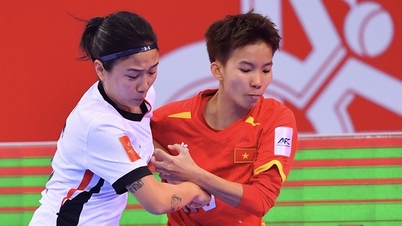

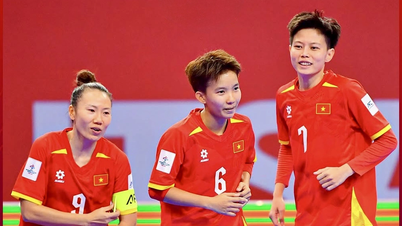














































![[Photo] Prime Minister Pham Minh Chinh talks on the phone with Singaporean Prime Minister Lawrence Wong](https://vphoto.vietnam.vn/thumb/402x226/vietnam/resource/IMAGE/2025/5/8/e2eab082d9bc4fc4a360b28fa0ab94de)































Comment (0)